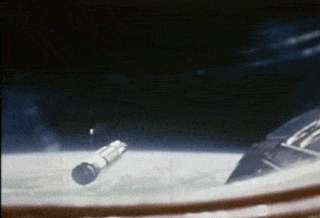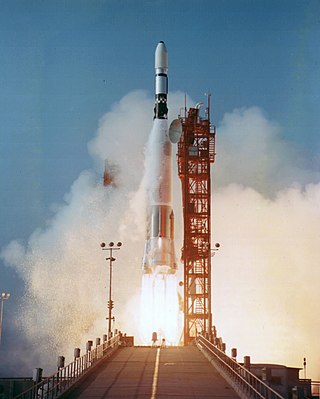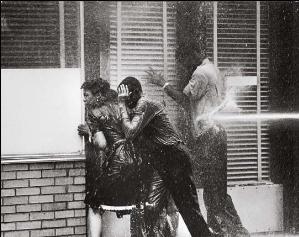
Gemini 10 was a 1966 crewed spaceflight in NASA's Gemini program. It was the 8th crewed Gemini flight, the 16th crewed American flight, and the 24th spaceflight of all time. During the mission, flown by future STS-1 Commander John Young and future Apollo 11 Command Module Pilot Michael Collins, Collins became the first person to perform two extravehicular activities.

Project Mercury was the first human spaceflight program of the United States, running from 1958 through 1963. An early highlight of the Space Race, its goal was to put a man into Earth orbit and return him safely, ideally before the Soviet Union. Taken over from the US Air Force by the newly created civilian space agency NASA, it conducted 20 uncrewed developmental flights, and six successful flights by astronauts. The program, which took its name from Roman mythology, cost $2.68 billion. The astronauts were collectively known as the "Mercury Seven", and each spacecraft was given a name ending with a "7" by its pilot.

Mercury-Atlas 9 was the final crewed space mission of the U.S. Mercury program, launched on May 15, 1963, from Launch Complex 14 at Cape Canaveral, Florida. The spacecraft, named Faith 7, completed 22 Earth orbits before splashing down in the Pacific Ocean, piloted by astronaut Gordon Cooper, then a United States Air Force major. The Atlas rocket was No. 130-D, and the Mercury spacecraft was No. 20. As of January 2024, this mission marks the last time an American was launched alone to conduct an entirely solo orbital mission.

John Watts Young was an American astronaut, naval officer and aviator, test pilot, and aeronautical engineer. He became the 9th person to walk on the Moon as commander of the Apollo 16 mission in 1972. He is the only astronaut to fly on four different classes of spacecraft: Gemini, the Apollo command and service module, the Apollo Lunar Module and the Space Shuttle.

Walter Marty Schirra Jr. was an American naval aviator, test pilot, and NASA astronaut. In 1959, he became one of the original seven astronauts chosen for Project Mercury, which was the United States' first effort to put humans into space. On October 3, 1962, he flew the six-orbit, nine-hour, Mercury-Atlas 8 mission, in a spacecraft he nicknamed Sigma 7, becoming the fifth American and ninth human to travel into space. In December 1965, as part of the two-man Gemini program, he achieved the first space rendezvous, station-keeping his Gemini 6A spacecraft within 1 foot (30 cm) of the sister Gemini 7 spacecraft. In October 1968, he commanded Apollo 7, an 11-day low Earth orbit shakedown test of the three-man Apollo Command/Service Module and the first crewed launch for the Apollo program.

Leroy Gordon Cooper Jr. was an American aerospace engineer, test pilot, United States Air Force pilot, and the youngest of the seven original astronauts in Project Mercury, the first human space program of the United States. Cooper learned to fly as a child, and after service in the United States Marine Corps during World War II, he was commissioned into the United States Air Force in 1949. After service as a fighter pilot, he qualified as a test pilot in 1956, and was selected as an astronaut in 1959.

Gemini 6A was a 1965 crewed United States spaceflight in NASA's Gemini program. The mission, flown by Wally Schirra and Thomas P. Stafford, achieved the first crewed rendezvous with another spacecraft, its sister Gemini 7. Although the Soviet Union had twice previously launched simultaneous pairs of Vostok spacecraft, these established radio contact with each other, but they had no ability to adjust their orbits in order to rendezvous and came no closer than several kilometers of each other, while the Gemini 6 and 7 spacecraft came as close as one foot (30 cm) and could have docked had they been so equipped.

Gemini 8 was the sixth crewed spaceflight in NASA's Gemini program. It was launched on March 16, 1966, and was the 14th crewed American flight and the 22nd crewed spaceflight overall. The mission conducted the first docking of two spacecraft in orbit, but also suffered the first critical in-space system failure of a U.S. spacecraft which threatened the lives of the astronauts and required an immediate abort of the mission. The crew returned to Earth safely.

Gemini 1 was the first mission in NASA's Gemini program. An uncrewed test flight of the Gemini spacecraft, its main objectives were to test the structural integrity of the new spacecraft and modified Titan II launch vehicle. It was also the first test of the new tracking and communication systems for the Gemini program and provided training for the ground support crews for the first crewed missions.

Mercury-Atlas 10 (MA-10) was a cancelled early crewed space mission, which would have been the last flight in NASA's Mercury program. It was planned as a three-day extended mission, to launch in late 1963; the spacecraft, Freedom 7-II, would have been flown by Alan Shepard, a veteran of the suborbital Mercury-Redstone 3 mission in 1961. However, it was cancelled after the success of the one-day Mercury-Atlas 9 mission in May 1963, to allow NASA to focus its efforts on the more advanced two-man Gemini program.

Project Gemini was the second United States human spaceflight program to fly. Conducted after the first American crewed space program, Project Mercury, while the Apollo program was still in early development, Gemini was conceived in 1961 and concluded in 1966. The Gemini spacecraft carried a two-astronaut crew. Ten Gemini crews and 16 individual astronauts flew low Earth orbit (LEO) missions during 1965 and 1966.

A space capsule is a spacecraft designed to transport cargo, scientific experiments, and/or astronauts to and from space. Capsules are distinguished from other spacecraft by the ability to survive reentry and return a payload to the Earth's surface from orbit or sub-orbit, and are distinguished from other types of recoverable spacecraft by their blunt shape, not having wings and often containing little fuel other than what is necessary for a safe return. Capsule-based crewed spacecraft such as Soyuz or Orion are often supported by a service or adapter module, and sometimes augmented with an extra module for extended space operations. Capsules make up the majority of crewed spacecraft designs, although one crewed spaceplane, the Space Shuttle, has flown in orbit.

Earth orbit rendezvous (EOR) is a method for conducting round trip human flights to the Moon, involving the use of space rendezvous to assemble, and possibly fuel, components of a translunar vehicle in low Earth orbit. It was considered and ultimately rejected in favor of lunar orbit rendezvous (LOR) for NASA's Apollo program of the 1960s and 1970s, mainly because LOR does not require a spacecraft big enough to both make the return trip from Earth orbit to splash down in the ocean, and a soft landing on the lunar surface. Three decades later, it was planned to be used for Project Constellation, until that program's cancellation in October 2010.

NASA Astronaut Group 3—'The Fourteen'—was a group of fourteen astronauts selected by NASA for the Gemini and Apollo program. Their selection was announced in October 1963. Seven were from the United States Air Force, four from the United States Navy, one was from the United States Marine Corps and two were civilians. Four died in training accidents before they could fly in space. All of the surviving ten flew Apollo missions; five also flew Gemini missions. Buzz Aldrin, Alan Bean, Gene Cernan and David Scott walked on the Moon.

The Atlas-Agena was an American expendable launch system derived from the SM-65 Atlas missile. It was a member of the Atlas family of rockets, and was launched 109 times between 1960 and 1978. It was used to launch the first five Mariner uncrewed probes to the planets Venus and Mars, and the Ranger and Lunar Orbiter uncrewed probes to the Moon. The upper stage was also used as an uncrewed orbital target vehicle for the Gemini crewed spacecraft to practice rendezvous and docking. However, the launch vehicle family was originally developed for the Air Force and most of its launches were classified DoD payloads.
Advanced Gemini is a number of proposals that would have extended the Gemini program by the addition of various missions, including crewed low Earth orbit, circumlunar and lunar landing missions. Gemini was the second crewed spaceflight program operated by NASA, and consisted of a two-seat spacecraft capable of maneuvering in orbit, docking with uncrewed spacecraft such as Agena Target Vehicles, and allowing the crew to perform tethered extra-vehicular activities.

The following events occurred in December 1961:

The following events occurred in August 1962:

The following events occurred in June 1963:

The following events occurred in April 1963:

























